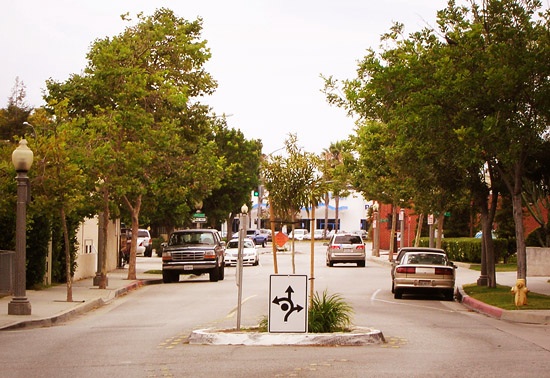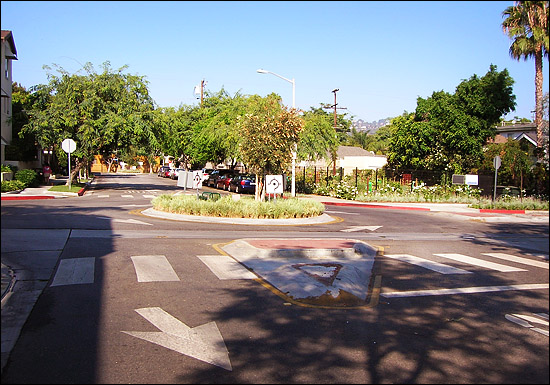A few weeks ago I wrote on this blog concerning the roundabouts LADOT has proposed for the 4th Street bicycle boulevard project. I was concerned that the design they showed was a type that has seemed not only ineffective but counterproductive when I’ve seen it in action. I have personally witnessed maniac drivers speeding around the wrong sides of the scrawny roundabouts on Culver City’s Higuera Street, not once but often, as they sought to circumvent traffic. Not a good thing!
But roundabouts seem to be on the LADOT’s mind a lot these days–possibly because they are cheap to install and count as “traffic calming” on the books whether they work or not. But they can work, if you do them right.
And by chance I came across some more effective roundabouts just yesterday, only a few miles north of Higuera in West Hollywood. It is worthwile to compare the two.
To refresh your memories, here is the photo of a Culver City roundabout:

Note that is is very small, requiring barely any diversion to get around, and therefore inducing barely any slowing. Note also that is lacks any guidance structures, though there is an instructive sign. (And anyone who’s stood by a corner stop sign or residential speed limit placard knows that people always obey signs…yeah, right!)
Also–and this matters, because residents and visitors to a neighborhood have a right to a pleasant life–the landscaping is perfunctory and banal.
Now here is the West Hollywood roundabout:

Notice that it is a little larger, and that it supplements the sign with pavement markings. But more than that: there are concrete islands that feed traffic into the roundabout in the proper direction and force a reduction in speed.
These are intelligently-designed diverters: the curb angle is such that emergency vehicles can drive over them if they must, but they are high enough to make them effective speed bumps that will jostle any potential scofflaws and induce them to drive civilly.
They also feature cut-throughs for foot traffic using the prominent crosswalks, which are themselves a traffic-calming device.
And the landscaping is better, though subtle and easy-maintenance. The plantings tell traffic, wheeled or shod, that the city respects people’s sentiments and cares a little about their lives. People usually return respect to such attentions.
So roundabouts can be done well and work effectively without costing much more than the cheap useless road crap that’s often spread out for our supposed benefit.
However, it’s up to us to make sure the right thing gets done.
“Us” includes you, dear reader. And one way you can get involved–one very good way–is to come to the Bike Plan Implementation Team meetings if you can. Next one’s on Tuesday, October 4th from 1PM to 4PM, at a new location: the California Bear Credit Union’s Community Meeting Room on the first floor of the CalTrans building. That’s the Giant Squatting Robot at 1st and Main downtown. There are bike racks out front and a bike corral in the underground parking, as well as easy Metro access. Read details here.
2 Comments
Here’s an example of a roundabout in Santa Monica – 26th Street:
http://maps.google.com/maps?q=26th+santa+monica&ll=34.03856,-118.480511&spn=0.000036,0.027874&fb=1&gl=us&cid=0,0,13060557212781531556&t=h&z=16&vpsrc=6&layer=c&cbll=34.038534,-118.48043&panoid=hSVwrHptUemam7rVL5w-Rg&cbp=12,321.68,,0,16.21
The biggest roundabout stumbling block for cities is fitting them into an intersection without having to take private property at the corners of the intersection. If a roundabout is big enough to presage the reconfiguration of sidewalks (90 degree corners getting smoothed into curves), ADA requirements for sidewalks will push them into private property on the corners. Cities, clearly, will do practically anything to avoid the quagmire of taking property.
Keeping that in mind can really help in creating the best outcome possible for roundabouts. Advocates demanding a design that requires property taking is as much a non-starter for cities as wimpy roundabouts are for bicyclists. If we can jointly craft a roundabout that everyone can get on board with, the more likely it’ll be that we’ll actually see said roundabout in the near future. One design element I’d favor is that, instead of expanding the size of the roundabout, extend the sidewalks at the intersection with bulbouts to reduce the ability of drivers to blow through the intersection.
But yeah, Culver City roundabouts = too small. The WeHo roundabout is also more friendly to emergency vehicles; the angled apron (instead of Culver City’s standard curb) can allow them to mount the roundabout in emergency situations.
One Trackback
[…] stop. You can read more about mini-roundabouts thanks to a recent blog post by Richard Risemberg here, and there’s additional information on the FHWA website […]